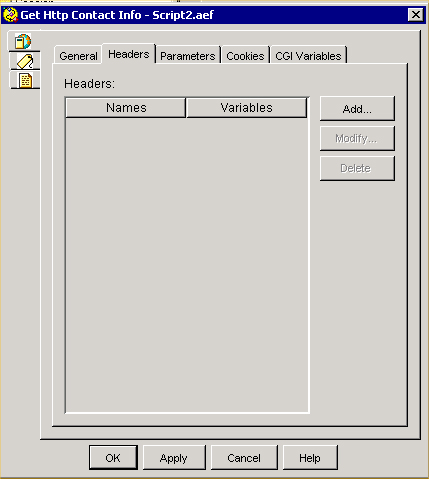Headers tab (Get Http Contact Info step)
Use the Headers tab of the Get Http Contact Info customizer window to display the HTTP headers that you have mapped to local variables.

HTTP headers contain general information such as the type of browser or the version of HTTP used. Each header provides one value, which is identified by the header name.
As an example, you may use information from HTTP headers in advanced scripts to customize the behavior of your script for different HTTP versions or for different browser types.
HTTP provides four types of headers:
-
General—Used by both servers and clients (browsers).
-
Server—Used only by servers.
-
Request—Used only by clients (browsers). Common HTTP Request Headers include:
-
Accept. Preferred media type.
-
Authorization. Client user name and password.
-
From. E-mail address of the client.
-
Host. Host name and port number of the server receiving the original request.
-
Referrer. URL of the source document.
-
User-Agent. Browser type.
-
-
Entity—Used by servers and by clients using POST or PUT methods.
Note | For detailed information about these or other headers, refer to any HTTP reference guide. |
The following table describes the properties of the Headers tab of the Get Http Contact Info customizer window:
|
Property |
Description |
||
|---|---|---|---|
|
Headers (Names and Variables) |
The names of the headers and the corresponding variables that map to the headers. |
||
|
Add / Modify (buttons) |
Use these buttons to access the Header dialog box. Use the dialog to specify the following:
When done, click OK.
|
||
|
Delete (button) |
To remove HTTP Header information, highlight a value in the list and click Delete. |